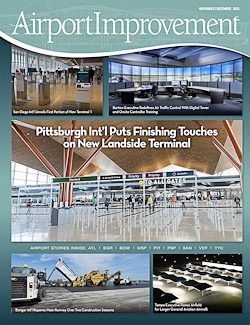Large or small, landside or airside, all airport construction comes with unique challenges. As one of the fastest-growing airports in the United States, Asheville Regional (AVL) in North Carolina is battling a particularly formidable set of circumstances. The mission for President/Chief Executive Officer Lew Bleiweis and his team: demolish their woefully undersized terminal and rebuild a larger version on the same footprint…without interrupting service.
 If that strikes you as a difficult feat, you’re not alone.
If that strikes you as a difficult feat, you’re not alone.
“We think this is one of the most complex aviation projects that is going on in the country,” says John Baumeister, operations manager for construction manager at risk Hensel Phelps. “I have not done something like this on such a small footprint.”
In June, AVL and its project partners completed Phase 1 of the two-phase $370 million terminal expansion. Select demolition and other preliminary work for Phase 2 will move forward in the next several months, but construction of the second half of the terminal cannot begin until the new air traffic control tower has been commissioned. Crews broke ground on that $50 million project in January 2023, and completion is expected in spring 2026.
| facts&figures
Project: New Terminal Location: Asheville Regional Airport, in NC Size: Nearly 327,00 sq. ft. Cost: $370 million (Phase 1 cost about $228 million) Funding: Federal & state grants; public bonds; airport user fees & non-aeronautical revenue Construction: 2023-late 2027 or early 2028 (Phase 1 completed June 2025) Key Components: Additional ticketing counters & airline office space; expanded TSA checkpoint; larger hold rooms; increase from 7 to 12 gates; new baggage handling system with larger carousels; new concessions; larger restrooms; nursing mothers’ room; new seating with electrical plug-ins; new central energy building Associated Project: $50 million FAA Tower Construction Manager at Risk: Hensel Phelps Architecture & Interior Design: Gresham Smith Owner’s Representative/Construction Manager: Parsons Mechanical & Electrical Engineering: AME Consulting Engineers Special Systems & Fire Protection Engineering Design; Code Consulting: Arora Engineers Outbound Baggage Handling System: Automatic Systems Inc.; Brock Solutions Boarding Bridges: thyssenkrupp Electrochromic Glass: SageGlass Seating: Arconas; Furniture Planners Inc. Key Benefits: Improved passenger experience; increased operational efficiency; additional space for expanded commercial service |
The existing air traffic control tower is more than 62 years old and located within the existing terminal, which also dates back to the early 1960s. The new tower will be an entirely separate structure.
The new terminal is the primary component of AVL Forward, a $420 million capital improvement program that has been a long time coming for the air gateway to Western North Carolina. Throughout the years, the region has become a popular vacation destination, with tourists flying into AVL to enjoy the Blue Ridge Mountains, top-rated mountain biking and the region’s vibrant arts scene, foodie culture and frothy lineup of craft breweries.
As Bleiweis explains, it took AVL nearly 60 years to hit the 1 million annual passenger mark. But after it surpassed that seminal milestone in 2018 and again the following year, the airport quickly exceeded 2 million annual passengers in 2023. With 43% growth in 2019, AVL would have likely served more than 2 million passengers in 2020 had it not been for the COVID-19 pandemic, adds Bleiweis.
“We’re not the only airport in the U.S. experiencing this type of growth, but we’re one of the few,” he remarks. “We saw what was coming down the road and knew we needed to increase the size of the terminal building.”
Half at a Time
Beginning in 2023, the airport began operating out of the south half of the terminal so crews could demolish the north half and rebuild in the same area. The new facilities and a temporary TSA passenger checkpoint opened in stages this summer—a strategy that will be repeated in Phase 2.
The new ticket lobby opened on June 11, followed by the new second-floor North Concourse on June 25. The new concourse’s eight gates were operational by the end of July. Phase 2 will add four more. Under its previous configuration, AVL had a total of seven gates.
Phase 1 of the expansion project also added an updated central energy plant located north of the terminal. This removes all cooling and heating equipment from the terminal itself.
The recently completed North Concourse, which totals 150,000 square feet, features newly designed spaces, modern amenities, several new food service options and views of mountain landscapes through floor-to-ceiling electrochromic glass that auto-tints as the sunlight changes. Installing roughly 19,000 square feet of SageGlass allowed the airport to capitalize on one of the region’s top natural assets without suffering the negative effects of glare or excessive heat gain.
The new facility is a tantalizing preview of the final product: a two-story, two-concourse, 12-gate terminal spanning 275,000 square feet. By contrast, the original terminal was 150,000 square feet after several updates throughout the years.
Phase 2 of the expansion project is underway with demolition in parts of the south half of the original terminal; construction is expected to be finished by early 2028.
It Started With a Vision
The airport worked closely with Gresham Smith on the new terminal design, repeating it’s previous collaboration on a multistory parking garage. Because the team was essentially starting with a blank slate, it conducted “decision visioning workshops” with a wide range of stakeholders, from airport staff and airport authority members to business leaders and the general public.
“You start with all kinds of pictures and thought imaging to come down to what you’re actually looking for in your final design,” Bleiweis explains.
The planning team intended to hold traditional public meetings but instead had to pivot to virtual versions due to the COVID-19 pandemic. It also sent out questionnaires and received more than 4,000 responses from community members.
The goal was to determine how the airport could become a reflection of the area AVL serves, explains Brad Sucher, senior vice president at Gresham Smith.
Receiving input from the community early in the process helped architects land on a theme/mission statement for the two-phase project: “a modern gateway humbly rooted in timeless natural beauty.” In turn, that led to color palettes and tactile materials that represent western North Carolina.
“The driving question we asked ourselves whenever we made decisions was, ‘What is the essence of this building?’” says Sucher. “That’s how we knew whether something we chose was suited to be part of this project.”
Gresham Smith steered the interior design decisions with assistance from the airport and key stakeholders. A stone and metal-clad vestibule welcomes visitors into the expanded ticketing area on the ground floor. After checking in, passengers continue through the temporary security checkpoint and proceed to the upper level. There, the column-free design creates a spacious and airy environment, with natural light and unobstructed views along the entire length of the North Concourse. A pattern in the terrazzo flooring that mimics rivers in the region helps lead travelers to the gate areas.
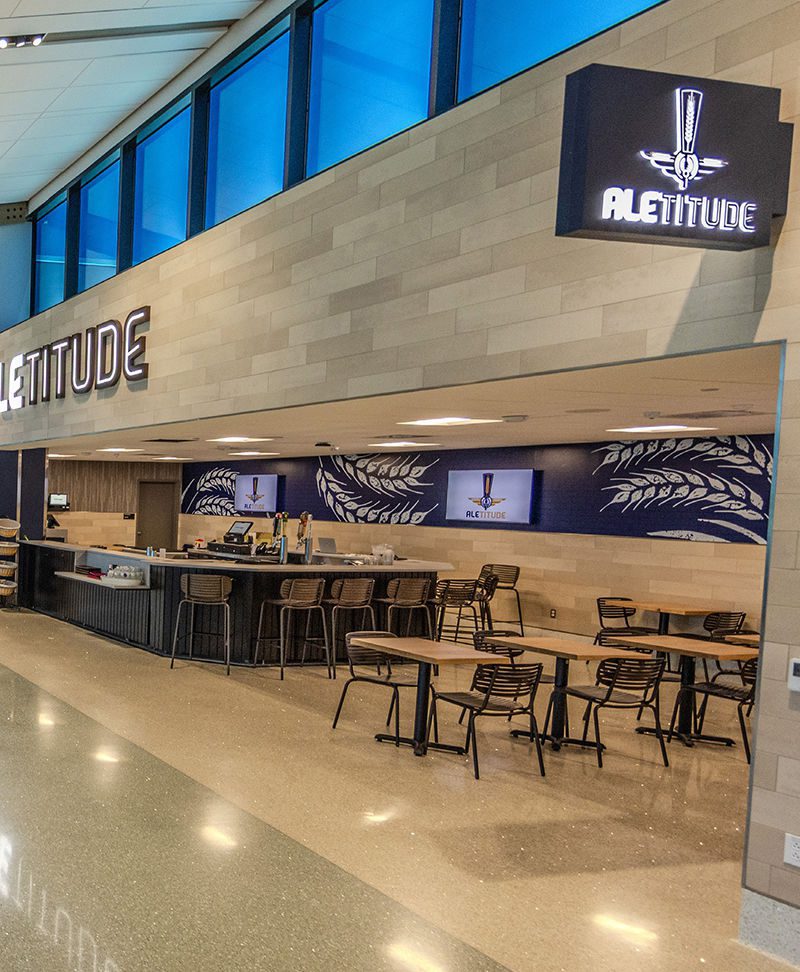
There are eight different types of seating in a variety of shapes, sizes, fabrics and textures. All, however, include charging units for electronics—an important amenity for passengers.
No detail was too small to consider. For instance, the project team asked a new mother to try several rocking chair options before selecting one for the new nursing mothers’ room.
Visual and Functional Improvements
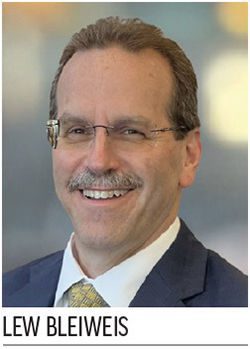 Bleiweis reports that the recent terminal makeover has been immediately impactful for customers. Some passengers who regularly fly into AVL said the improvements initially caused them to pause and question whether they had landed at the wrong airport. To ease the transition, airport staffers and volunteers were stationed throughout the new facility during the opening weeks to answer questions and help travelers find their way.
Bleiweis reports that the recent terminal makeover has been immediately impactful for customers. Some passengers who regularly fly into AVL said the improvements initially caused them to pause and question whether they had landed at the wrong airport. To ease the transition, airport staffers and volunteers were stationed throughout the new facility during the opening weeks to answer questions and help travelers find their way.
While many visitors comment on aesthetic improvements, the new concourse also features less noticeable, but important, operational upgrades such as a new baggage handling system with upgraded checked baggage inspection. According to airport personnel, the average processing time for a bag to travel from ticketing through screening and to the baggage makeup unit is just three minutes. The new makeup unit is twice the size of the temporary belt that airlines used during construction. Plans for Phase 2 call for a second baggage makeup unit and an outbound oversized baggage belt to further increase capacity and efficiency for the airlines and TSA.
The airport also purchased new jet bridges from thyssenkrupp. Fixed portions of the boarding bridges were designed so tug traffic can pass underneath them to travel between the baggage makeup units and gates. The bridges vary in length (some two tunnels, others three) to accommodate a wide variety of traffic, from small regional jets to full-sized Group III aircraft such as 737s and A320s.

An expanded ticketing lobby with more ervice counters will help serve tourists and other travelers.
Travelers are using a temporary TSA checkpoint until Phase 2 of the terminal project is completed. The permanent one will feature six lanes, with room to add two more if needed. Last year, growing passenger volume prompted the addition of a fourth screening checkpoint to accommodate the increase.
A temporary loading dock was used to receive supplies during Phase 1. A new dedicated dock with its own access road will be constructed during Phase 2 so delivery vehicles will not add to traffic on the main road into the terminal.
An Extra Advocate
The airport hired Parsons as project manager for both phases of the terminal reconstruction. During Phase 1, Vin Del Nero led an onsite team that included himself, an IT technician and a project manager who coordinates with the construction partners.
As Del Nero describes it, Parsons served as an extension of AVL so airport staff could focus on their own everyday responsibilities. On a practical level, he reviewed funding authorizations, change orders and the schedule, and advised airport management when dates were slipping or there were questions about the process.
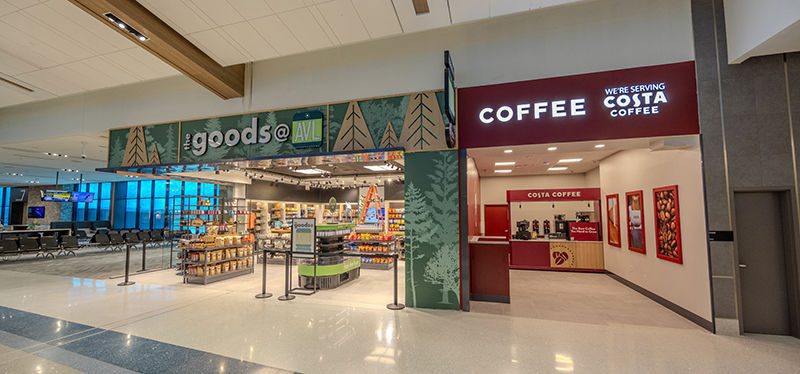
The North Concourse includes several new food and beverage concessions.
“This project was one of the most challenging I’ve ever had to deal with because it has such a small footprint,” Del Nero notes.
To help compensate for the size constraints, AVL leveraged temporary facilities. Three gates operated out of modular buildings after the north half of the terminal was no longer usable, and rental car counters were removed and housed in a temporary structure south of the terminal.
Having an outside project manager proved especially helpful when original plans to rebuild the south end of the terminal first had to be scrapped because COVID-19 delayed construction of the new air traffic control tower. As a result, the airport had to keep the existing tower in operation and pivot instead to building the north end of the terminal during Phase 1.
“It’s a good thing we had a contractor and a client that understood it all,” Del Nero reflects.
Maintaining a continual flow of clear information was emphasized to keep the project on time and on budget. All key stakeholders met weekly initially and more often when needed—sometimes multiple times per day.
“The lines of communication must stay open, and that was very simple with this client,” Del Nero says. “If we needed something answered, it would get answered quickly. Problems we’ve had with other projects occurred when the lines of communication stopped. [The AVL project] certainly had its challenges, but we talked them out and worked through them.”
Undeterred
Some of the most disruptive challenges were caused by Hurricane Helene, which devastated western North Carolina in late September 2024. Although the airport suffered minimal damage, it became a hub for delivering rescue supplies throughout the region. Constructing the new terminal temporarily took a back seat to helping communities that were ravaged by the storm. Even so, Phase 1 of the project was completed on time and on budget.
Other significant challenges stemmed from changing the original architectural plans to accommodate passenger growth that surpassed planners’ initial expectations. For example, the airport is expanding its central TSA checkpoint from four to six lanes (with the capability to bump up to eight lanes if necessary). It’s also adding a third luggage carousel to the baggage claim area that will be built during Phase 2.
Gresham Smith not only focused on achieving the right look and feel for the facility, it also prioritized programming and creating future flexibility.
“Fleet mixes are changing; airlines are upgauging,” Sucher explains. “We needed the new terminal to serve smaller aircraft in the near term, but we also needed to be able to double those holdrooms and gates to make a single position for larger aircraft. We looked at every operation inside of that facility to see how we could scale up to match peer airports in the region in the most sensible and flexible manner.”
Project partners never had to compromise what they hoped to achieve with the new terminal despite the unique challenge of “building on top of, next to, around, underneath and adjacent to the existing operation,” he emphasizes.
“It did drive the ultimate layout and configuration of the terminal,” he adds, “but we never let [the result] stray from the essence of what we wanted this facility to be. We never changed decisions because of a phasing reason. We always found a solution around that.”
It’s a daunting task for an airport to keep pace when passenger volume doubles in a mere five years. That’s why AVL’s new terminal is designed to handle 4 million annual passengers and grow beyond that, including additional gates if needed.
In the meantime, the North Carolina airport is capping its number of airlines to five and restricting overall daily flight volume until the new terminal is completed. Additional airlines, however, are waiting for approval to begin service at AVL.
Bleiweis acknowledges that it’s scary to think about how quickly the airport could reach 4 million passengers per year. But that’s what makes operating one of the fastest-growing airports in the country so much fun.
| From the C Suite
Lexie Farmer, chief operating officer of Asheville Regional Airport (AVL), played a vital role in completing Phase 1 of the airport’s $370 million terminal rebuilding project, and her continued leadership will be critical to ensuring Phase 2 goes smoothly.
In this Q&A, Farmer talks about the importance of working with experienced partners, lessons from the project’s first phase and the importance of celebrating the intermediate milestones as a team. AI: Building a new terminal on the same footprint as the existing terminal while also keeping the airport operating seems unfathomable. Was there a model or any precedent for the approach you took? LF: This was the main reason we chose to do this project via construction manager at risk. This project delivery method is best for complex projects with challenging phasing. My experience was similar at CLT with the terminal lobby expansion project. It built new and renovated old while continuing to operate. However, the easy part of that job was that it did not include gates or jet bridges. This challenging project is also the main reason for selecting Parsons as program manager. Their team helped manage the Raleigh-Durham International Airport (RDU) Terminal 2 replacement and Terminal 1 modernization program. AI: The AVL team and all its partners in this project have emphasized the importance of candid and frequent communication to stay on time, on target and develop creative solutions when they’re needed. What is the secret not only to generating that type of back and forth, but also being able to act quickly and reach agreements when pivots are necessary? LF: Having weekly OAC [owner-architect-contractor] meetings and weekly construction site walks to monitor the progress. As we got within a few months of opening, we added weekly touch bases between the contractor, designer and the owner to make sure we were addressing high-priority items. There also was a mutual respect between the parties and encouraging everyone to think outside the box to address challenges. AI: The second phase of this project involves demolishing the remaining half of the existing terminal and building the second half of the new one. What are the most important lessons from the first phase that you are taking into the second phase? LF: Whatever plan you come up with, there will be something that can and will cause a roadblock that you didn’t see coming. Two big challenges were the elevator/escalator and fire inspections. These were items that timing is sometimes out of your control, so the lesson we’ve learned is to plan space between the inspections and public opening to ensure approval and certificate of occupancy are obtained with more ease in the process. Another lesson we learned is to give the concessions more time to upfit their space so their teams have adequate time for training in the space before opening to the public. Although there are many more, the last lesson learned that I’ll share is to make certain that in Phase 2 we have complete phasing and temporary construction plans. This will help us better understand the impacts early so we can mitigate. AI: Are there one or two things that were on your wish list for the new terminal that you had to let go of? LF: I would have liked to see an updated canopy from the terminal to the parking garage and additional passenger boarding lifts for the transportation of wheelchairs and other large items, as we only have one in each concourse. AI: Airport executives and their teams get little time to bask in the joy of a completed project because there is always another one on the to-do list. What steps did you take in this first phase of the project to ensure your team recognized their achievement? LF: From someone who has worked many construction projects that lead to opening new facilities, I love the fact that the AVL executive staff made sure the employees got to have their reveal and party before any other planned reveal. It was really touching and made the employees appreciate their role in making this happen. |

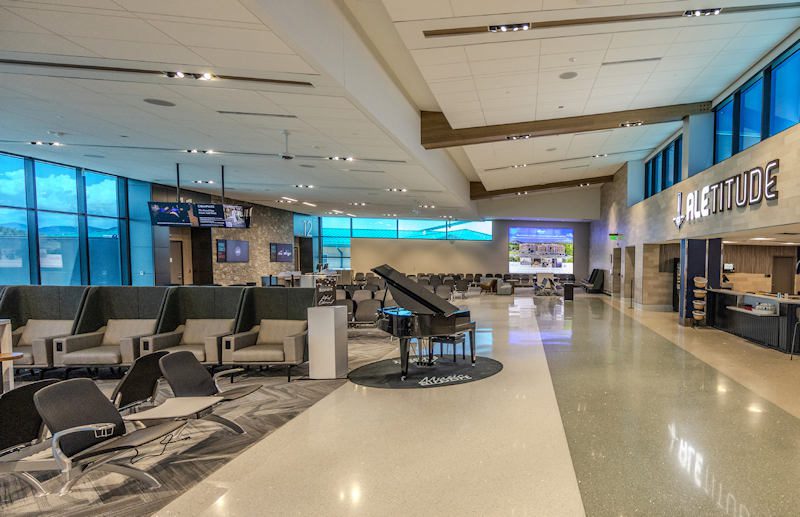
 Prior to joining the executive team at AVL in spring 2024, Farmer worked as airport operations director for Charlotte Douglas International Airport (CLT). Before that, she held leadership positions at several other airports, including General Mitchell International (MKE) in Milwaukee, Dane County Regional (MSN) in Madison, WI, and Hartsfield-Jackson Atlanta International Airport (ATL).
Prior to joining the executive team at AVL in spring 2024, Farmer worked as airport operations director for Charlotte Douglas International Airport (CLT). Before that, she held leadership positions at several other airports, including General Mitchell International (MKE) in Milwaukee, Dane County Regional (MSN) in Madison, WI, and Hartsfield-Jackson Atlanta International Airport (ATL).